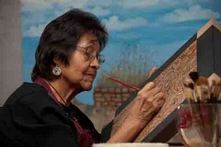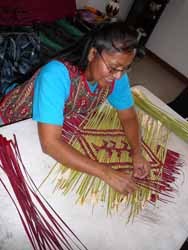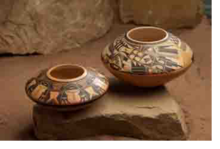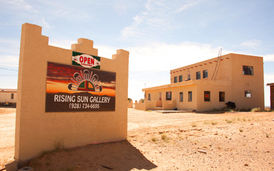For Immediate Release
Tuesday, July 10th, 2012
Contact: Mike Finney
Visitors Welcome on Hopi Arts Trail
 |
| Frances Quotskuyva, Painter |
Upper Moenkopi, AZ – Hopi artists are renowned for their distinctive silverwork, basketry, pottery, and their unique Katsina Doll carvings. Artists and galleries across the Hopi mesas are now welcoming the world to come visit Hopi Land, and get to know more about their art and culture by traveling on the Hopi Arts Trail. The Hopi Arts Trail is a cooperative effort of Hopi owned galleries, Hopi artists, and Hopi guides in the villages across the Hopi reservation. There are approximately a dozen galleries across Hopi, most of which are family-owned by the artists.
The Hopi people have lived in villages on First, Second, and Third Mesas in northeastern Arizona for over a thousand years. Their culture and way of life is one of the most uniquely preserved cultures in the nation. While language custom and tradition are similar across the mesas, each region has features that are unique from one another.
Second Mesa artist and gallery owner Roy Talahaftewa says, “It has been rewarding to see artists and galleries join the Arts Trail. Many of us travel to distant cities to attend art shows and other events but it is much more rewarding to have visitors come to Hopi where they can learn about our culture and see our beautiful land.” Certified Hopi Guide and award winning sculptor Evelyn Fredericks says, “First time visitors are sometimes intimidated because our land and villages are so different from mainstream communities. The Hopi Arts Trail will show the world how welcoming Hopi are. We hope visitors come to spend more than a day, take a tour, and become collectors of the art they discover.”
Hopi artists are among the most accomplished in the world. In Hopi, there are four primary art forms: Pottery, Carving, Basketry/Weaving, and Silversmithing/Jewelry. The artists have all learned from mentors, whom are usually family members. This tradition of mentoring continues today. Artists from all of the villages across the Hopi mesas carve Katsina Dolls, but the other art forms are the specialty of particular villages on First, Second, and Third Mesas. Hopi artists also find expression in painting, sculpture, glass making, photography, and other contemporary art forms to make uniquely Hopi interpretations of their world. As with other artists, their art is ever changing and evolving but always recognizably Hopi.
 |
| Iva Honyestewa, Weaver |
BASKETRY/WEAVING Hopi baskets are derived from techniques that can be traced back for thousands of years. Hopi artists produce plaques, bowls, and trays for ceremonial use as well as for sale. Artists from Third Mesa are particularly known for their wicker style of basketry.
CARVING / KATSINAS These carvings are called “dolls,” but they are actually three-dimensional representations of the Katsinas who visit the villages for religious and ceremonial reasons. They are carved from cottonwood root and typically painted with bright colors. These dolls have been used for many generations to teach the Hopi children about their religion and culture.
 |
| Pottery by Karen Abeita |
POTTERY The design and artistic decoration of Hopi pottery has evolved over the centuries. Hopi pottery is made with the “coil and scrape” technique, with clay that is hand dug on Hopi land. Designs are painted in natural pigments with a yucca leaf brush, and the pots are fired in open pits with sheep dung and cedar as fuel. Most Hopi pottery comes from artists on First Mesa.
 |
| Rising Sun Gallery, Second Mesa |
JEWELRY & SILVERWORK The most widely known silver work is the process of silver overlay, which was developed by Hopi artists after World War II. The artist cuts a design from one flat piece of silver, then fuses that piece to a darker, oxidized one that is scored or incised to produce a fine texture. The upper piece is then polished or buffed, giving the art unique Hopi character. Silver is predominantly produced in the villages of Second and Third Mesas.
Traveling across Hopi is easy – simply follow Arizona State highway 264 which connects the Upper Village of Moenkopi at the Western Gateway to Hopi with the other villages. You will travel through some of the most open and pristine land in the American west. The Hopi villages are “living” villages – the original homes are still intact and have been continuously occupied for centuries. When visitors enter the villages they are entering into the current lifestyle of the people in the villages.
The Hopi Arts Trail was conceived by the Upper Moenkopi Village to enhance opportunity for all Hopi. The Upper Village of Moenkopi is the Western Gateway to Hopi situated across from the Navajo community of Tuba City midway between the Grand Canyon and Monument Valley. The Village of Moenkopi opened the Moenkopi Legacy Inn & Suites in 2010 and the hotel has been recognized by travelers and FODOR’s Travel as one of the finest lodging establishments in Arizona.
Upper Village of Moenkopi Governor William Charley says “Unemployment on the Hopi Reservation exceeds 50% and that is why we created the Hopi Arts Trail. The creation of jobs and income on Hopi land translates directly into preservation of culture, language, religion and family. We want to encourage visitors to come to meet our artists and tour respectfully in Hopi and take home memories and art for their enjoyment.”
For more information, visit www.hopiartstrail.com.
###
For image bank, visit www.hopiartstrail.com/
Maralyn D. Hill, The Epicurean Explorer
President, International Food Wine & Travel Writers Association
Blogs: Where and What in the World & Success with Writing
https://authorcentral.amazon.
Follow me: @maralynhill
FB: http://www.facebook.com/The.Epicurean.Explorer,, http://www.facebook.com/WhereandWhat.intheWorld, http://www.facebook.com/Success.With.Writing
Linkedin: http://www.linkedin.com/in/maralynhill





